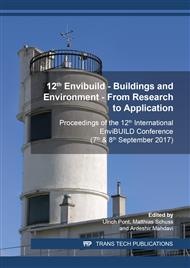p.109
p.117
p.129
p.140
p.148
p.156
p.164
p.172
p.181
Villa Castelli - Transformation of Historical Building into Nearly Zero Energy Building
Abstract:
What Americas Cup and a heritage building have in common They both aim at innovative technologies and cutting-edge solutions. The owner of the project, an ex-crew member of the most famous sailing match race in the world, pushed the planning team to develop extraordinary solutions for his house. The house, Villa Castelli, is an historical listed building located on the Como lake. During its history, it has been transformed many times, giving as results a non-uniform structure composed by different construction technologies. The aims of the owner were: an overall refurbishment particularly focused on energy efficiency, the exploitation of renewable energy sources based on-site production and a fixed budget. To reach these goals, the energy needs have been reduced improving the performance of the thermal envelope. Then, the building's technical systems have been re-developed in order to exploit as much as possible available renewable energy sources. From the very beginning, it was clear that, for finding optimal solutions, a multidisciplinary approach was necessary. The design approach should be the result of a shared approach integrating different fields, such as creative design, technology, knowledge of material properties, building physics. The great synergy among building envelope retrofitting, innovative technological solutions and the deployment of renewable energy sources allows the transformation of this historical listed building into an outstanding example of a nearly zero energy building (nZEB).
Info:
Periodical:
Pages:
148-155
Citation:
Online since:
January 2019
Authors:
Price:
Сopyright:
© 2019 Trans Tech Publications Ltd. All Rights Reserved
Share:
Citation:


